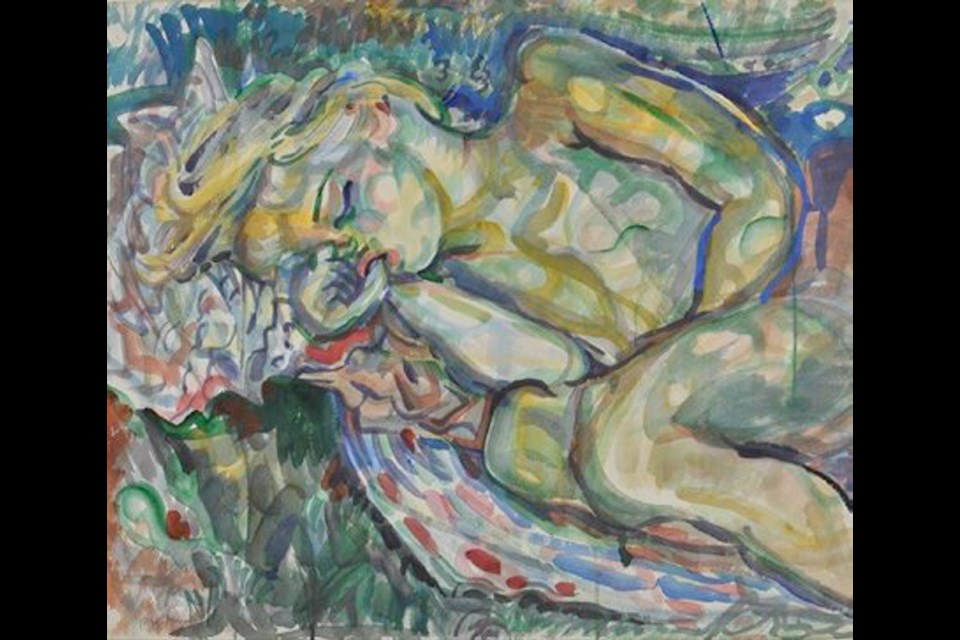What: Water + Pigment + Paper: Experiments in Watercolour from the AGGV Collection
Where: Art Gallery of Greater Victoria
When: Opens Saturday, continues to May 23. Public reception (free admission) is Friday, 8 p.m. to 10 p.m.
Admission: $13 (adults), $11 (students, seniors), $2.50 (youth), free for five and under.
For some, the words “watercolour painting” conjure up images of hobbyists or genteel Victorian women. The notion is: serious artists use oil paint.
A new exhibition at the Art Gallery of Greater Victoria aims to counteract such stereotypes.
“Sometimes people think of watercolour as a gentle, demure medium. But really challenging things can be done with it,” said the gallery’s Nicole Stanbridge, who co-curated the show with colleague Michelle Jacques.
Featuring about 130 paintings, Water + Pigment + Paper is one of the largest (if not the largest) watercolour exhibits in the gallery’s history. It spans nearly two centuries, from the late 1700s to the 1970s. Some of the works have been in storage since the 1950s.
Artists such as Emily Carr, Pat Martin Bates, Pegi Nicol MacLeod, Jack Shadbolt and Maxwell Bates are included. So is famed English art critic John Ruskin (a pair of dainty cockle-clam images) and Victoria’s Maude Lettice, a contemporary of Carr’s who started as a polite watercolourist but later experimented with bolder styles.
Shadbolt’s Dog Among the Ruins (1947) is among the most dramatic paintings. It depicts a hound with its head thrown back, painted in sickly yellows and greens, howling amid the smoking ruins of a city. Disturbing and unforgettable, it’s a far cry from polite plein air watercolour landscapes one associates with middle-class dabblers.
Equally dramatic, albeit in a different way, is Jane’s Asleep, a 1944 work by MacLeod. An Ontario painter who became a notable wartime artist, MacLeod portrays a sleeping girl, thumb in her mouth. Sensual and powerful, it’s created with strong, semi-abstract curves and bold colours that recall Fauvists such as Henri Matisse.
“She was really avant garde in her time,” Stanbridge said. “She’s just a really important figure in art history.”
Much of the appeal of Water + Pigment + Paper lies in its diversity and scope. Art movements touched upon include Romanticism, Pre-Raphaelite, Arts and Crafts, Modernism and Abstract Expressionism.
There are 19th-century paintings in the English landscape tradition of J.M.W. Turner. These range from a traditional landscape by the British watercolourist John Varley (an ancestor of Group of Seven artist Fred Varley) to Sunset Landscape by Canadian artist George Reid. The Reid work, painted in 1891, shows trees reflected in water in a diffuse manner that’s atmospheric, even abstract.
Cricket and Spider on Grass, thought to have been painted in the 1700s, is by Asian artist Yan Hua. Stanbridge notes the painter’s abstract approach (leaves and twigs are reduced to a few brush strokes) typifies the Asian style that later influenced European painters, particularly the Impressionists.
“These painters were emulating the essence of nature, as opposed to this highly rendered, detailed approach. It’s an impression of nature,” she said.
Artists from Victoria’s Limners group are represented, including Myfanwy Pavelic and Herbert Siebner. The exhibition includes a series of small, sketch-style works that Siebner donated to the gallery in 1965. Produced in 1962, these images inspired by the artist’s travels in Canada and Europe were reproduced in the Victoria Daily Times.
Curator Jacques says there’s an “amazingly” large number of works by women in Water + Pigment + Paper: 27 of the artists are female and 40 are men. Some, such as Victoria’s Sophie Pemberton (the first woman to win the Prix Julian from the Academie Julian for portraiture), were hobbyists who ultimately excelled in a field dominated by men.
“It may have started as a hobby. But then they became really competent and really skilled artists in their own right,” Jacques said.
“Don’t underestimate the [watercolour] medium, what people can do and have done with it. That’s what I think has been really exciting about this.”


-thumb.png;w=120;h=80;mode=crop)
